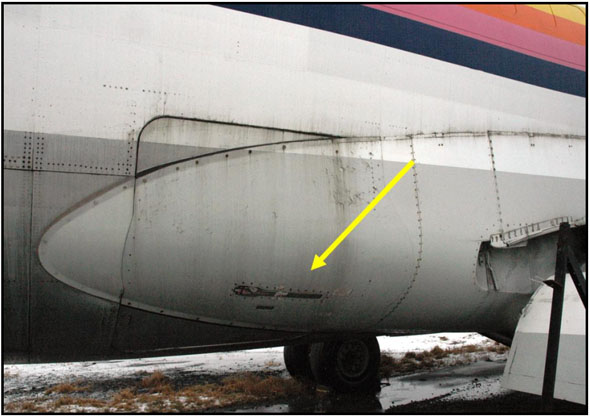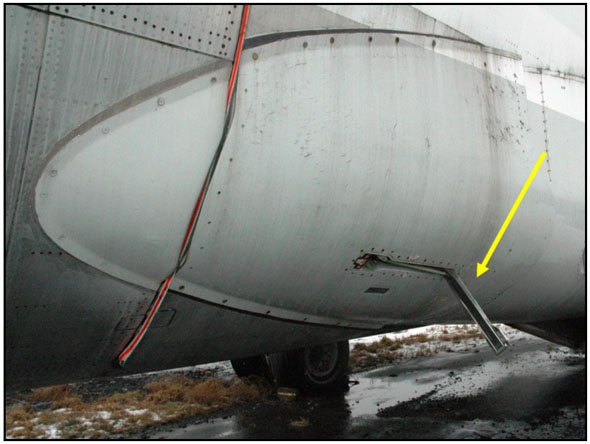Cargo Door Opening on Take-Off
Kelowna Flightcraft Air Charter Ltd.
Boeing 727-227 C-GJKF
Regina, Saskatchewan
The Transportation Safety Board of Canada (TSB) investigated this occurrence for the purpose of advancing transportation safety. It is not the function of the Board to assign fault or determine civil or criminal liability. This report is not created for use in the context of legal, disciplinary or other proceedings. See Ownership and use of content. Masculine pronouns and position titles may be used to signify all genders to comply with the Canadian Transportation Accident Investigation and Safety Board Act (S.C. 1989, c. 3).
Summary
Kelowna Flightcraft Air Charter Ltd. Flight 284 (KFA284), a Boeing 727-227 (registration C-GJKF, serial number 21042), departed Regina, Saskatchewan, on a scheduled cargo flight to Hamilton, Ontario. Shortly after rotation, the crew noticed that the aft cargo door warning light was illuminated, followed by irregular indications of the number 3 engine. The crew decided to shut down the number 3 engine and divert to Saskatoon, Saskatchewan, at an altitude of 10 000 feet. The aircraft landed safely at 0710 central standard time with airport rescue and firefighting (ARFF) on standby. The aft cargo door was found open with the door handle stowed in the locked position. There were no injuries. The aircraft sustained minor damage to the aft cargo door hinges. There was no damage to the door structure or latching mechanism.
Factual information
KFA284 was operated by Kelowna Flightcraft Air Charter Ltd. and was chartered by Purolator Courier, a cargo transport service. Purolator Courier provided the ground handling for the aircraft.
Records indicate that the aircraft was maintained in accordance with Kelowna Flightcraft Air Charter Ltd.'s approved maintenance control system. The flight crew was certified, qualified, and met the crew rest requirements for the flight, in accordance with existing regulations. Weather and runway conditions were not factors in this occurrence.
Information from the flight data recorder (FDR) was retrieved. The FDR was an older model capable of recording only 11 parameters; it did not record the status of the annunciator panel lights. FDR data indicated a sudden fluctuation of the number 3 engine pressure ratio (EPR) approximately 2 minutes 30 seconds after rotation, at an altitude of 7600 feet above sea level (asl). The cockpit voice recorder (CVR) was a 30-minute tape unit, and details concerning the occurrence flight were overwritten during the flight.
The cargo door, hinges, latch cams and microswitch were sent to the TSB Engineering Laboratory for further analysis. Inspection and bench testing of the door and microswitch revealed no anomalies. The aft cargo door is equipped with an instructional placard indicating how the door should be locked. The instruction reads as follows: "LEAVE HANDLE EXTENDED WHEN LOCKING DOOR" (see Photo 1). Discussions with the operator indicate that the placard was viewed by the operator as an instruction. The manufacturer viewed the placard as a caution only, to avoid damage to the door mechanism.
KFA284 arrived in Regina on a flight from Hamilton, and the aft cargo hold area of the aircraft was unloaded at approximately 0500 central standard time.Footnote 1 After unloading the aft cargo hold, the ramp attendant was advised by another ramp attendant to leave the door open. The ramp attendant then left the rear of the aircraft to assist in loading the main cargo compartment. Another ramp attendant, on instructions from the lead hand, determined that the aft cargo hold would not be used. None of the ramp attendants recalled locking the aft cargo door.
The Purolator Courier aircraft ramp operations manual, which governs cargo door operation by the ramp attendants, did not designate a specific ramp attendant as responsible for belly compartment cargo door operation and security. There was no consistent understanding as to who was responsible for cargo door procedures among the ramp attendants who serviced the occurrence flight.
The Boeing 727 normal checklist indicates that the second officer is to check for door security before engine start. This check includes the examination of the cargo doors through an actual physical inspection of the door during the walk-around, and a check of the warning light in the cockpit. After the ground personnel finished loading the aircraft, the second officer conducted the walk-around inspection of the aircraft and did not notice any anomalies with the aft cargo door. After securing the aircraft entrance door, the second officer began a pre-start check. He did not see the aft cargo door warning light illuminated.
The aft cargo door warning light is designed to be illuminated when the aft cargo door is not locked. The aft cargo door warning light does not activate the master warning system, and is located such that it is normally only visible to the second officer; it is on the second officer's annunciator panel, directly below the auxiliary power unit (APU) light. The engines were started andKFA284 taxied to the runway for departure. The aircraft was observed from a distance, and no anomalies were noticed with the aft cargo door.
After departure, when the cargo door anomaly was noted, the crew was not certain of the cause of the indication, or of the aircraft's flight characteristics during a turn, if the aft cargo door was open. They elected to divert the flight to Saskatoon because of its proximity.
After landing, inspection of the aft cargo door and airframe structure revealed that the forward door hinge was bent rearward as a result of air loads on the open door in flight. The door, door frame structure, surrounding airframe structure, and latching mechanisms were not damaged. Inspection and operational tests of the aft cargo door warning light system revealed no discrepancies. A visual and borescope inspection of the number 3 engine revealed no anomalies.
The cargo door is opened from the outside by depressing a small, finger-access panel and pulling the door handle out of its recess approximately 90° perpendicular to the cargo door. The door handle, assisted by an overcentre spring, actuates a torque tube that unlocks/withdraws the overcentre latch rollers from their respective cams, resulting in an upward and outward movement of the door. A door counter-balance system assists in opening the door, and a telescopic strut is used to support the door once it is open. A handle on the inside of the door can also be used to open the cargo door, but cannot be used to lock the door.
The first step in locking the cargo door is to close the door against the door frame while the external handle is fully extended. When the door is fully closed, the latch rollers are lined up with their respective cams. Movement/retraction of the handle inserts the overcentre latch rollers into their respective cams, resulting in the locking/inward and downward movement of the door. The door handle is then stowed into its recess (see Photo 2).
Further tests were carried out on an exemplary Boeing 727-227 aircraft. Numerous operational tests of the aft cargo door could not produce a condition that would extinguish the aft cargo door light on the second officer's annunciator panel and yet leave the door unlocked. Tests revealed that the door was able to close against the door frame and remain in position, with the handle fully extended (see Photo 3).
When the cargo door is open, the handle extends outward approximately 90° into the slip stream (see Photo 3). Previous analysis was conducted by Boeing and the United States National Transportation Safety Board on the external door handle of the cargo door, as a result of a similar occurrence. The analysis concluded that an airspeed of 190 knots produced a sufficient aerodynamic force to close the handle far enough to allow the spring forces inside the cargo door to pull the handle completely closed, even though the cargo door itself remained open. The maximum speed attained during the occurrence flight was in excess of 250 knots indicated airspeed.
A search of the United States Federal Aviation Administration's Service Difficulty Report website revealed several occurrences involving false cargo door warning indications. In nearly all occurrences, the false warning was the result of a dirty or contaminated microswitch.
Analysis
The wording on the instructional placard of the aft cargo door can be misleading. Literal adherence to the instruction suggests that the door is locked when the handle is extended. It was determined that the wording on the instructional placard did not contribute to the occurrence.
The loading and unloading of KFA284 was carried out during the early hours of the morning, in the dark. It is likely that the cargo door was closed but not locked. Despite the position of the door handle, an unlocked aft cargo door in a closed position may appear to be locked, especially from a distance in the dark (see photos 2 and 3).
After the aircraft became airborne, aerodynamic forces caused the unlocked aft cargo door to open. The door is located in close proximity to the number 3 engine inlet. Opening of the door would have produced an interruption in air flow to the number 3 engine inlet, resulting in irregular EPR indications. It is likely that the slip stream produced enough force in flight to close the extended door handle.
It was determined that the geometry of the door and latching mechanisms do not allow the aft cargo door light to extinguish unless the cargo door is properly closed in place and locked. Functional tests of the aft cargo door warning system and examination of the microswitch suggest that the warning system was functioning normally.
Because of the relative position of the door warning and APU caution lights, the two lights can be confused with one another. If the door warning light is mistaken for the APU light (with the APU shutdown), it is possible that the door warning may not be noticed until after take-off where it is again required to be checked.
The following TSB Engineering Laboratory report was completed:
- LP127/2006 – Analysis of Cargo Door
This report is available from the Transportation Safety Board of Canada upon request.
Findings
Findings as to causes and contributing factors
- The aft cargo door was most likely closed but not locked before take-off, and it opened after departure due to aerodynamic forces.
- The ground crew did not check the aft cargo door for security before take-off, and as a result, the door was not locked.
- The flight crew members did not discover the unlocked aft cargo door during the walk-around inspection, nor did they notice the aft cargo door warning light before departure.
Findings as to risk
- The ramp attendants were not required by their procedures to ensure that the cargo doors were properly closed.
- The instructional placard on the aft cargo door describing how to lock the door contained misleading instructions.
Safety action
Safety action taken
After the occurrence, Purolator Courier amended its ramp operations manual by introducing a checklist that requires ramp attendants to ensure the security of cargo doors. The checklist is required to be initialled by ramp personnel after the completion of each aircraft loading operation.
On 27 February 2007, the TSB issued two occurrence bulletins concerning the instructions on the cargo door placard, and the cargo door closing procedures. The purpose of occurrence bulletins is to apprise Transport Canada and others in the aviation community in a timely manner of certain information that may raise potential operational or technical concerns.
This report concludes the Transportation Safety Board's investigation into this occurrence. Consequently, the Board authorized the release of this report on .


